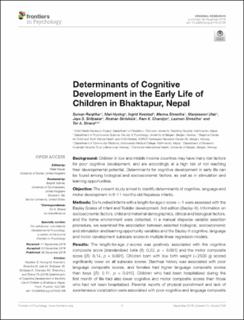| dc.contributor.author | Ranjitkar, Suman | |
| dc.contributor.author | Hysing, Mari | |
| dc.contributor.author | Kvestad, Ingrid | |
| dc.contributor.author | Shrestha, Merina | |
| dc.contributor.author | Ulak, Manjeswori | |
| dc.contributor.author | Shilpakar, Jaya Shree | |
| dc.contributor.author | Sintakala, Roshan | |
| dc.contributor.author | Chandyo, Ram Krishna | |
| dc.contributor.author | Shrestha, Laxman | |
| dc.contributor.author | Strand, Tor A | |
| dc.date.accessioned | 2020-06-02T13:12:14Z | |
| dc.date.available | 2020-06-02T13:12:14Z | |
| dc.date.created | 2020-01-07T18:13:13Z | |
| dc.date.issued | 2019 | |
| dc.identifier.citation | Front Psychol . 2019 Dec 6;10:2739. doi: 10.3389/fpsyg.2019.02739. eCollection 2019 | en_US |
| dc.identifier.issn | 1664-1078 | |
| dc.identifier.uri | https://hdl.handle.net/11250/2656209 | |
| dc.description.abstract | Background: Children in low and middle income countries may have many risk factors for poor cognitive development, and are accordingly at a high risk of not reaching their developmental potential. Determinants for cognitive development in early life can be found among biological and socioeconomic factors, as well as in stimulation and learning opportunities. Objective: The present study aimed to identify determinants of cognitive, language and motor development in 6-11 months old Nepalese infants. Methods: Six hundred infants with a length-for-age z-score <-1 were assessed with the Bayley Scales of Infant and Toddler development, 3rd edition (Bayley-III). Information on socioeconomic factors, child and maternal demographics, clinical and biological factors, and the home environment were collected. In a manual stepwise variable selection procedure, we examined the association between selected biological, socioeconomic and stimulation and learning opportunity variables and the Bayley-III cognitive, language and motor development subscale scores in multiple linear regression models. Results: The length-for-age z-scores was positively associated with the cognitive composite score [standardized beta (ß): 0.22, p < 0.001] and the motor composite score [(ß): 0.14, p = 0.001]. Children born with low birth weight (<2500 g) scored significantly lower on all subscale scores. Diarrheal history was associated with poor language composite scores, and females had higher language composite scores than boys [(ß): 0.11, p = 0.015]. Children who had been hospitalized during the first month of life had also lower cognitive and motor composite scores than those who had not been hospitalized. Parental reports of physical punishment and lack of spontaneous vocalization were associated with poor cognitive and language composite scores, respectively. The statistical models with the various subscale scores as dependent variables explained between 8 to 16 percent of the variability in the cognitive developmental outcomes. Conclusion: Our findings reveal important determinants for developmental scores in infancy, and underline the role of biological risk factors faced by marginalized children in low and middle income countries such as in Nepal. Copyright © 2019 Ranjitkar, Hysing, Kvestad, Shrestha, Ulak, Shilpakar, Sintakala, Chandyo, Shrestha and Strand. | en_US |
| dc.description.sponsorship | This work was supported by the Thrasher Research Fund (award
11512) and GC Rieber Funds | en_US |
| dc.language.iso | eng | en_US |
| dc.relation.uri | https://www.ncbi.nlm.nih.gov/pmc/articles/PMC6915069/pdf/fpsyg-10-02739.pdf | |
| dc.rights | Navngivelse 4.0 Internasjonal | * |
| dc.rights.uri | http://creativecommons.org/licenses/by/4.0/deed.no | * |
| dc.subject | Bayley scales of infant and toddler development; | en_US |
| dc.subject | biological factors; | en_US |
| dc.subject | cognitive development; | en_US |
| dc.subject | environmental stimulation; | en_US |
| dc.subject | manual stepwise procedure; | en_US |
| dc.subject | socioeconomic factors | en_US |
| dc.title | Determinants of Cognitive Development in the Early Life of Children in Bhaktapur, Nepal | en_US |
| dc.type | Peer reviewed | en_US |
| dc.type | Journal article | en_US |
| dc.rights.holder | Copyright © 2019 Ranjitkar, Hysing, Kvestad, Shrestha, Ulak, Shilpakar, Sintakala,
Chandyo, Shrestha and Strand. This is an open-access article distributed under the
terms of the Creative Commons Attribution License (CC BY). The use, distribution
or reproduction in other forums is permitted, provided the original author(s) and
the copyright owner(s) are credited and that the original publication in this journal
is cited, in accordance with accepted academic practice. No use, distribution or
reproduction is permitted which does not comply with these terms. | en_US |
| dc.source.pagenumber | 10 | en_US |
| dc.source.volume | 10 | en_US |
| dc.source.journal | Frontiers in Psychology | en_US |
| dc.source.issue | 2739 | en_US |
| dc.identifier.doi | 10.3389/fpsyg.2019.02739 | |
| dc.identifier.cristin | 1768017 | |
| cristin.unitcode | 1991,6,0,0 | |
| cristin.unitname | Div Lillehammer | |
| cristin.ispublished | true | |
| cristin.qualitycode | 2 | |

